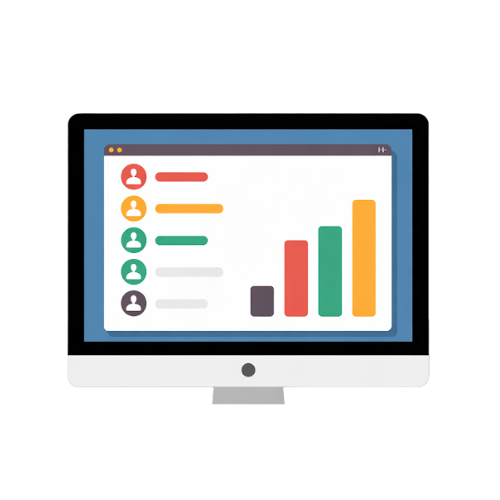Companies today face increasingly complex challenges in managing resources. Production capacities must be maximized, teams need to be allocated efficiently, and material inventory must be tightly controlled. Yet many businesses still rely on outdated, manual planning methods or rigid systems.
The problem? Lack of transparency, slow reaction times, and inefficient use of resources lead to bottlenecks, unnecessary costs, and production delays. That’s where digital tools come in. Modern capacity planning software helps you manage resources effectively, detect bottlenecks early, and streamline operations.
This article explores why these tools are indispensable for efficient resource planning and how they can improve productivity and competitiveness.

Why Manual Resource Planning Holds You Back (And What to Do Instead)?
In today’s fast-paced business world, resources are one of the most valuable assets—but using them efficiently is no easy task. Many companies deal with scattered data, manual coordination, and a lack of visibility in their planning processes. As a result, growing businesses often face avoidable bottlenecks, inefficiencies, and extra costs.

When machines sit idle due to missing materials, or projects stall because staff are overloaded, the root cause is often poor resource control. Why is this so difficult to manage? Manual methods are time-consuming, error-prone, and rigid.

Key Drawbacks of Manual Capacity Planning:
-
• Lack of transparency:
Resource data like machine usage, staff availability, or inventory is often scattered across systems. Without a central view, it’s hard to identify bottlenecks or optimize resources.
-
• High time consumption:
Manual planning involves constant coordination between departments, which eats up time and increases the risk of mistakes.
-
• Poor scalability:
As a company grows, manual planning quickly becomes unmanageable. Double-bookings and missed capacity issues arise.
-
• No real-time data:
Companies that lack real-time insights make decisions based on outdated numbers—hurting their productivity and delivery reliability.
Modern planning software simplifies processes, improves transparency, and enables proactive planning to avoid delays and resource conflicts.

How Resource Planning Software Improves Capacity Management?
Digital planning tools are key to smooth operations and optimal capacity use. Software solutions offer a wide range of benefits—from greater transparency to automated optimization.


Top Benefits of Capacity Planning Software:
Real-time resource visibility: Modern planning software brings all relevant data into one central dashboard.
- • Track machine and production capacity in real time
- • Optimize team and staff availability
- • Manage inventory and warehouse space efficiently
Example from manufacturing: A car parts supplier uses capacity planning software to track machine usage in real time. This helps them detect idle capacity early, improve workflows, and reduce downtime.
Accurate forecasting for smarter planning: Data-driven tools help predict future capacity gaps and adjust accordingly.
- • Demand forecasting based on historical and market trends
- • Automatic suggestions for capacity adjustments
Example from sales: A consumer goods company plans seasonal demand peaks using planning software. Algorithms help them scale production in advance, avoiding delivery delays.
Flexible scaling for growing businesses: Digital tools adapt to changing needs, whether you’re managing a small team or multiple sites.
Example from manufacturing: A mid-sized machine builder uses planning software across several factories to coordinate capacity and seamlessly add new locations.
Efficiency and cost savings: Automated planning not only saves time but significantly reduces costs:
- • Fewer overtime hours and idle resources
- • Less material waste thanks to accurate demand planning
- • Improved machine and personnel utilization
Example from events industry: An event company uses planning software to coordinate staff and equipment. With centralized resource planning, they avoid last-minute changes and save thousands of euros annually.

Choosing the Right Capacity Planning Software: What to Look For?
There are many tools on the market, but not every solution fits every company. Depending on your industry, size, and needs, you should prioritize certain features.
Must-have features for effective capacity planning:
- • Real-time data integration: Sync with machines, HR tools, and ERP systems to ensure all departments work with up-to-date information. Crucial for companies with complex operations or multiple locations.
- • Automated planning: Smart algorithms recommend the best resource allocation to avoid bottlenecks and boost efficiency. Great for businesses with fluctuating workloads.
- • Flexibility and scalability: Your solution should grow with your business and adapt to changing demands. This is especially important for startups and expanding firms.
- • Ease of use: An intuitive interface and fast setup are essential, particularly for small and medium-sized businesses without a dedicated IT team.
Which Tool Fits Which Business?

Each industry faces different planning challenges. Manufacturers focus on machinery and materials, while service providers need flexible staff and project coordination.
Here’s a quick breakdown of what to look for:
- Manufacturing: Tools with real-time machine data integration
- Agencies & service providers: Focus on staff planning and project tracking
- Logistics & retail: Inventory automation and demand forecasting
- Growing companies: Scalable solutions that adapt to new locations or teams
Tip: Before implementing any software, analyze where your current planning struggles the most. The best tool fits your processes—not the other way around.

Streamline Resources with Digital Tools
Efficient resource management is key to higher productivity, lower costs, and staying competitive. Capacity planning software enhances transparency, improves processes, and helps you adapt to changing market demands.
With tools like CapaPlanner you save time, reduce errors, and optimize resource use—giving you an edge in uncertain times.


